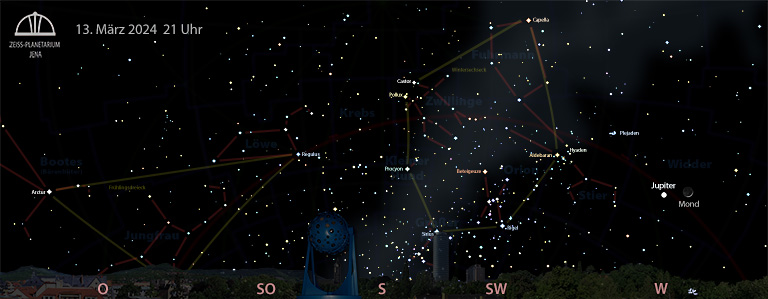Der Frühling beginnt
Am 20. März um ca. 4:05 Uhr bewegt sich von Jena aus gesehen der Mittelpunkt der Sonnenscheibe durch den Frühlingspunkt vor dem Sternbild Fische. Die Länge des hellen Tages nimmt nun deutlich zu. Rund 39 Grad Höhe über dem Horizont erreicht die Sonne hier in Jena, der lichthelle Tag hat nun etwas über 12 Stunden, mit Ausnahme der Pole, überall auf der Erde. Aber auf der Südhalbkugel beginnt der Herbst. Mit der Tagundnachtgleiche beginnt der Frühling 2024. Die Sonne bewegt sich scheinbar weiter in Richtung Wendekreis des antiken Sternzeichens Krebs, den sie am 20. Juni zu Sommerbeginn vor dem astronomischen Sternbild Stier erreichen wird.
Vollmond ist am 25. März, Neumond am 10.
Am 25. März ist der erste Frühlingsvollmond und somit ist am Sonntag danach, am 31. März, Ostersonntag.
Unter günstigen Bedingungen können wir ab Monatsmitte bis Ende März in der Dämmerung im Westen den raren Merkur, den innersten Planeten unseres Sonnensystems, entdecken. Den Riesenplaneten Jupiter können wir noch bis Ende April in der Dämmerung am nordwestlichen Horizont sehen.
Den Sternhimmel beherrschen im Südwesten noch die hellen Sterne des Wintersechsecks, unter anderem mit den Zwillingen Kastor und Pollux. Auch funkelt der hellste Stern am irdischen Himmel Sirius weiterhin über dem Südwesthorizont. Der Himmelsjäger Orion strebt dem Untergang im Westen zu.
Im Südosten erscheinen bereits die Sterne des Frühlingsdreiecks, beginnend mit Regulus im Löwen. Östlich folgen mit Arktur im Bärenhüter und darunter Spika in der Jungfrau die anderen Sterne des Dreiecks.
Am 31. März beginnt wieder die „Mitteleuropäische Sommerzeit“. Wir müssen die Uhren von 2 auf 3 Uhr vorstellen.
W. Don Eck
Zeiss-Planetarium Jena
The starry sky in March 2024
Spring begins
On 20 March at around 4:05 a.m., the centre of the sun’s disc moves through the vernal equinox in front of the constellation Pisces, as seen from Jena. The length of the bright day now increases significantly. The sun reaches around 39 degrees above the horizon here in Jena, and the bright day now lasts just over 12 hours, with the exception of the poles, everywhere on Earth. But autumn begins in the southern hemisphere. Spring 2024 begins with the equinox and the sun appears to move further towards the Tropic of Cancer, which it will reach on 20 June at the beginning of summer in front of the astronomical constellation Taurus.
Full moon is on 25 March, new moon on 10 March.
The first full moon of spring is on 25 March and so the Sunday after, 31 March, is Easter Sunday.
Under favourable conditions, we can discover the rare Mercury, the innermost planet in our solar system, in the twilight in the west from the middle of the month until the end of March. We can still see the giant planet Jupiter in the twilight on the north-western horizon until the end of April.
The starry sky in the south-west is still dominated by the bright stars of the winter hexagon, including the twins Castor and Pollux. The brightest star in the terrestrial sky, Sirius, also continues to twinkle above the south-west horizon. The celestial constellation Orion is heading towards its setting in the west.
The stars of the spring triangle already appear in the south-east, starting with Regulus in Leo. The other stars of the triangle follow to the east with Arcturus in Bear keeper and below it Spika in Virgo.
On 31 March, „Central European Summer Time“ begins again. We have to set our clocks forward from 2 to 3 o’clock.



